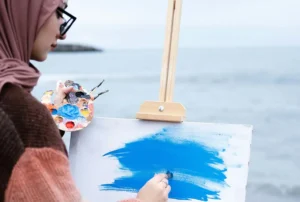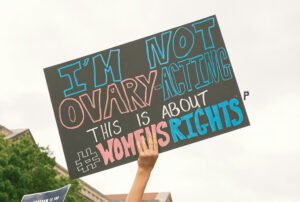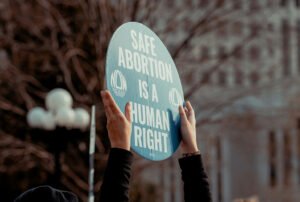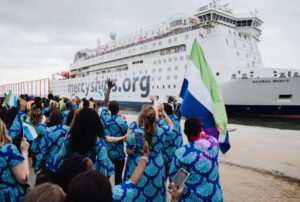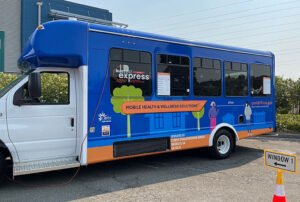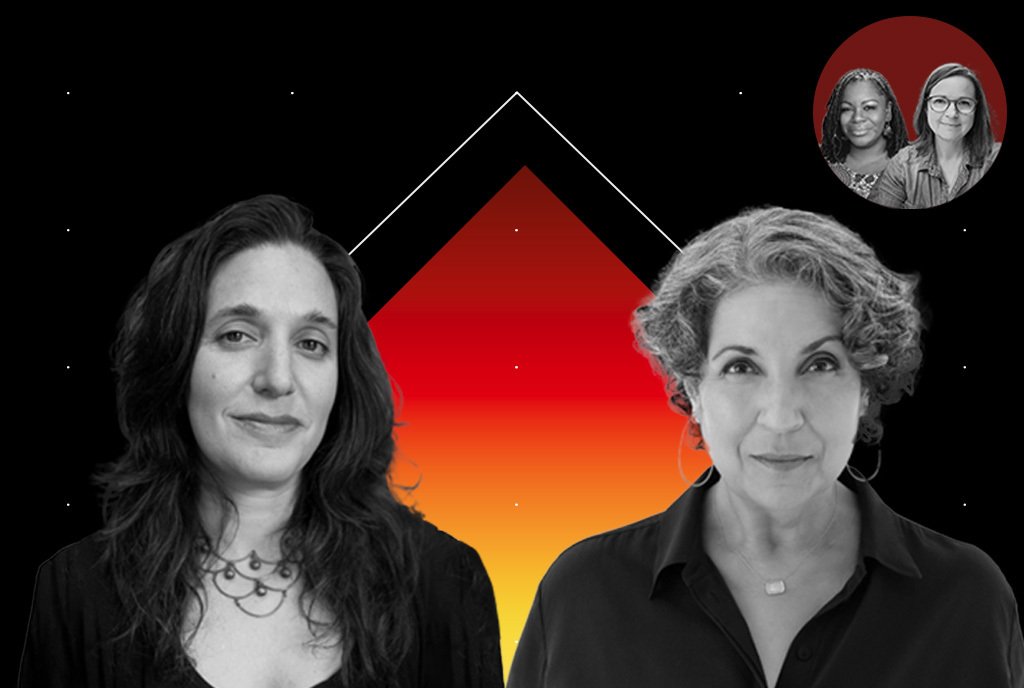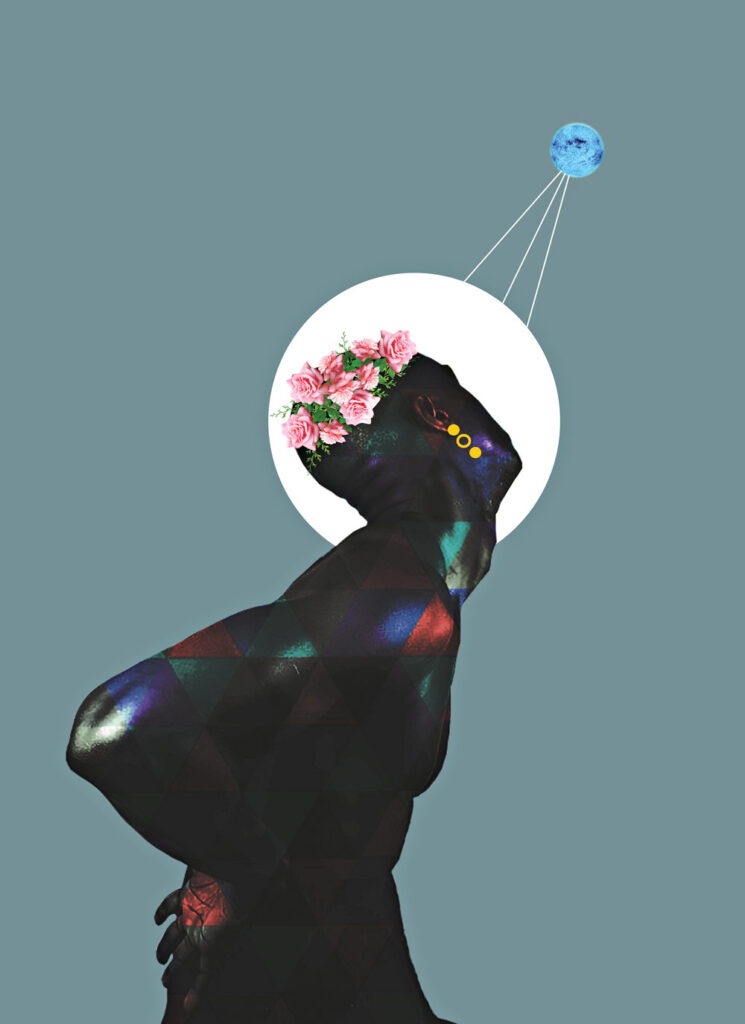
Editors’ note: This article is from NPQ’s winter 2022 issue, “New Narratives for Health.”
Click here to download this article as it appears in the magazine, with accompanying artwork.
Healing justice . . . is a framework that seeks to lift up resiliency and wellness practices as a transformative response to generational violence and trauma in our communities.
—Cara Page, cofounder, Kindred Southern Healing Justice Collective1.
“We all belong. We are all healing. We are all welcomed in our wholeness.” These words were draped across our lobby wall until the closure last December, after thirteen years of service, of our Third Root Community Health Center in Flatbush, Brooklyn—the oldest cooperative holistic health center in New York City. With basic healthcare being stripped away—and communities already impacted by intergenerational trauma experiencing the ongoing trauma of a pandemic, the repealing of reproductive rights, and an epidemic of gun violence—we decided, as we closed, to share our reflections and learning. With the benefit of hindsight, we have a clearer picture of some key factors that allowed us to grow and prosper, as well as some understanding of what we wish we had done better. Our hope is that our lessons learned can help future healing spaces to be rooted in right relationship with community and sustainable.
Healing justice is both a delicate and critical value to center in these times, for it can be a powerful guiding principle in moments of compounded crisis and trauma. Cara Page, cofounder of the Kindred Southern Healing Justice Collective, reminds us that the origins of healing justice lie in Southern Black Feminist practice and praxis,2 and that an integral part of healing justice practice is the dismantling of oppressive systems.
Our opening, in August 2008, was the culmination of the dreams of healers who envisioned holistic healthcare access for those most in need.
Third Root Community Health Center was created specifically to overcome historic inequities in health access,3 and we understand healing justice as the increased capacity for individuals, families, and communities to experience wellness while righting historical inequality regarding access to economic resources and healthcare.
Our opening, in August 2008, was the culmination of the dreams of healers who envisioned holistic healthcare access for those most in need, and was built upon previous health justice work—such as the Black Panthers’ health programs,4 the Young Lords,5 and more recent projects like Working Class Acupuncture and Off the Mat, Into the World.6 Third Root’s strategies for overcoming health inequalities were to offer sliding- scale holistic healthcare, herbal education, yoga, acupuncture, and massage for some of the most vulnerable residents in New York City. The founding structure was cooperative ownership with a consensus-based decision-making process. We began with seven founding members—Green Wayland-Llewellin, Jacoby Ballard, Robyn Ji-Hye Choi, Angela Ueckerman, John Halpin, Romina Rodriguez-Crosta, and Julia Bennett—a group of healers committed to equity, access, and cooperative ownership, who dreamed of a center that would be replicable across the world. Throughout Third Root’s lifetime, there were twenty cooperative owners (at its largest, the co-op had twelve worker-owners) and over one hundred and fifty staff, teachers, and volunteers whose contributions continuously evolved the culture of care.
Challenges in Collective Practice
And yet there were challenges. While we did succeed in providing a steadfast resource that many long-term BIPOC community members relied on for healing and community building, bringing services into a community that had been historically marginalized did not in and of itself overcome cultural and access barriers. Although Third Root aimed to serve those most impacted by health inequality, we found ourselves situated in one of the most rapidly gentrifying neighborhoods in Brooklyn.7 And because of historic gaps in access to holistic health modalities for working-class people of color, at least half of our patrons were white, and many were new city residents.8 The irony—given our mission, given that the practices of yoga, massage, and Chinese medicine and acupuncture come from people of color, and given that the staff and owners comprised more than 50 percent people of color—resulted in pain and harm to the community and the BIPOC staff and owners. And yet our work held distinction and profound meaning for people of color, especially those at the intersection of multiple marginalized identities. While BIPOC people may have had many beautiful, connected, and important healing experiences here as patrons, practitioners, collaborators, and/or one-time visitors or longstanding community members, those truths don’t erase the fundamental challenges around racial equity at Third Root— challenges that are important, if sometimes difficult, to reflect on.
We strove to rectify these gaps by increasing affinity group programming, offering free and lower cost services to BIPOC folks via application, inviting community feedback,9 and working internally with skilled facilitators to organize social justice training for all staff10—but challenging white supremacy in our own culture, language, and principles should have been a keystone of our founding and operations. As a holistic health business in a primarily Caribbean and Latinx neighborhood, the onus was on us to understand and undo our own privilege. From its inception, Third Root did plan and budget for anti-oppression training, but we failed to make this work central to our organizational culture—a core failure for an organization helming a healing space in a diverse and increasingly gentrifying neighborhood.
For our collective to sustain a commitment to undoing racial oppression and white supremacy on an ongoing basis, we needed to develop sustainable business practices that would allow us to invest in antiracism while navigating the paradox of being an anticapitalist cooperative that must meet a bottom line. For example, we ought to have begun and sustained our venture with antiracism training for staff and community members from an organization such as The People’s Institute for Survival and Beyond (PISAB);11 without a core, unwavering commitment to challenging white supremacy, when resource scarcity comes up—as it does for many small businesses—decisions may be made that exclude, disempower, and disinvest from the most marginalized.
And this is exactly what happened at Third Root when we began struggling to cover our basic operating expenses. Sadly, although we had a clear guide to our sliding-scale model, clients consistently self-selected into the bottom tiers of payment even when they could afford to pay more. We believe this is rooted in the internalized nature of resource scarcity in a capitalist system. And because our economic model was not sustainable, antiracist training and practice became peripheral over time, eroding the integrity of our mission and vision as a healing justice center committed to racial and economic justice. Third Root held many concurrent truths about race, healing, and community that were both imperfect and profound. Ultimately, we had to face that we would not be able to sustain our business with this model, and that irreparable faults at the very foundation of the venture played a critical role.
A COVID Non-Survival Story
With New York City at the epicenter of the first US wave of the pandemic, our community witnessed firsthand how COVID-19 rapidly accelerated the gap between those with adequate healthcare and those without.
And then COVID hit. Amid the COVID-19 economic shutdown, there have been many stories about organizations that pivoted in the pandemic and thrived. This was not the case for us. Understanding that our self-selecting sliding scale model was not sustainable, in late 2019 and early 2020 we designed a new justice pricing model with clear qualifying parameters for subsidized care. The new model identified specific groups most in need, lifting up BIPOC, formerly incarcerated, immigrant, queer, trans, and disabled community members, as well as those receiving public benefits—all of whom qualified for greatly reduced price services. High-income earners and those with intergenerational assets were asked to pay above-market rates, making accessible care possible for those most in need in our community. Tragically, the launch of the justice pricing model, complete with new marketing materials and web redesign, was timed for March 2020, just as the pandemic hit.
With New York City at the epicenter of the first US wave of the pandemic, our community witnessed firsthand how COVID-19 rapidly accelerated the gap between those with adequate healthcare and those without.
BIPOC and working-class communities here and across the United States suffered vast, disproportionate levels of illness, death, and economic loss throughout the pandemic. Additionally, in the wake of the murders of George Floyd and Brianna Taylor, the same communities were impacted by the ongoing and intergenerational trauma of police violence on Black and Brown bodies.
In response, during the summer of 2020, we implemented our Collective Care Fund, which allotted donated funds to cover low-fee and free massage, acupuncture, herbalism workshops, and yoga services for community members most impacted by health disparities. But like many small businesses, we weathered the prolonged crisis with no financial reserves. To maintain operations, we pared down staffing to a bare minimum, qualified for and drew down federal and state pandemic aid, and made many pivots in the model of service throughout the start-and-stop nature of repeated closures and reopenings.
We implemented online yoga and workshops, created an online marketing and outreach strategy, and offered outdoor services. Nonetheless, more than a year of sustained losses began to fracture an already tenuous financial situation. By mid-2021, faced with losing our lease and a long-shot option to relocate, we knew we could not shoestring our way out. Healing justice includes economic justice; and the confluence of challenges of running a business in New York City while aiming to pay a living and equitable wage amid a global pandemic led us to shutter our business.
We are honored and humbled to have had a vision and to have tried putting it into practice. Throughout our thirteen years, we centered the intention of “being with” change. Our growth and adaptation presented both obstacles and innovations, some of which are shared here. We know firsthand that mistakes can cause harm; they can also impart lessons when repairs are made.
Lessons Learned: Setting the Standards for Healing Justice
As a collectively owned and managed cooperative, we pondered deeply what it would mean to our community and staff if we were to close our doors. We found ourselves navigating the important question of when an organization has reached the end of its life cycle. Through this process, we realized that there is a gap in support services for cooperatives—many organizations assist start-up cooperatives, yet few effective supports exist for midrange cooperatives, cooperatives navigating financial hardship, and cooperatives attempting to pivot to avoid closure.12
As we shuttered our center, we developed a healing justice map to direct folks to similar resources;13 and below, we share our recommendations on healing justice practices for cooperatives and other businesses that are committed to racial, social, and economic justice.14 It is our hope that a network of healing justice organizations and beloved practitioners will continue to thrive and serve those in our community in need of the deep care and healing that they found in our space, and that this network of care will hold them on the next leg of their journey.15 (If you know of a healing justice business that you would like added to our map, you can submit it for consideration.16)
Based on our thirteen years of experience at Third Root, we offer healing justice businesses six recommendations for overcoming the effects of systemic inequality:
1. Ensure leadership by BIPOC and local community members
Optical allyship is allyship that only serves at the surface level to platform the “ally,” it makes a statement but doesn’t go beneath the surface and is not aimed at breaking away from the systems of power that oppress.
—Latham Thomas, founder, Mama Glow
Liberation practice’s definition of justice is healing the root cause. What equity means in liberation practice is ownership of the soil one lives on and compensation that allows Black and Brown folks to become and own their role as the fabric of a community. Like other institutional sectors, healthcare requires representation at the highest levels by people who share the lived experiences of those being served.
Health disparities reflect systemic inequality rooted in racial capitalism, leading to poor health outcomes and shorter life spans for Black and Brown people and BIPOC trans community members.17 For this reason, it is critical that those most impacted by health disparities in any community are at the forefront of healing efforts. Leaders living at the intersection of racism, classism, transphobia, and ableism are best able to articulate, envision, and lead practices that can truly heal a community.
It is also imperative that allied organizations and resourced individuals support training and professional development that provide rising BIPOC leaders with the mentorship, healing, and support needed to develop sustainable and holistic leadership practices necessary for long-term change (meaning, there can be no space for underpaid roles and burnout culture).
2. Offer sliding scale, free, or scholarship options
Life is very short. What we have to do must be done in the now.
—Audre Lorde, Sister Outsider
Equitable pricing is a core aspect of healing justice that creates access for folks who historically have been priced out of or made to feel unwelcome within mainstream wellness spaces that cater to high-paying clients. Besides the robust sliding scale Third Root maintained for all our programming for many years prior to the pandemic, our Collective Care Fund provided free and low-fee services to Black, Brown, and Indigenous people, the formerly incarcerated, intergenerational Brooklyn residents, trans folks, and disabled folks. We also offered a “no one turned away for lack of funds” option for many of our yoga classes, meditation classes, and workshops, as well as Community Care Days, which were free outdoor healing spaces.
Sign up for our free newsletters
Subscribe to NPQ's newsletters to have our top stories delivered directly to your inbox.
By signing up, you agree to our privacy policy and terms of use, and to receive messages from NPQ and our partners.
3. Pay a living and equitable wage
The economic system still depends on a profound racial hierarchy. It still depends on the degradation of Black labor and still depends on and develops tools to segregate and disenfranchise Black people and other working people.
—Jennifer L. Morgan, chair, New York University Department of Social and Cultural Analysis
The labor of people who are Black and Brown, Indigenous, immigrant, disabled, trans, formerly incarcerated, elderly, and female is undervalued, underpaid, and overlooked. As at Third Root we were at least 50 percent BlPOC in our ownership, staff, and teachers, and majority women and queer, our commitment to remain accessible to our students and patients came into conflict with our ability to pay ourselves equitably. We knew that if we failed to uplift and sustain our healing justice providers, we would not survive long enough to provide care to our clients. It was an ongoing struggle to balance our anticapitalist values with our need to become solvent, and payroll was always our highest overhead cost. With the additional challenge of the pandemic, we simply could not pay ourselves enough to fulfill a fundamental principle of our work: Healing justice includes economic justice.
We envision that living wages in a healing justice cooperative would account for the varied needs of cooperative members who are impacted differently by structural inequality. For example, some bear the costs of child care as single or partnered parents, some sustain multiple family members on their wages, some live and work with disability, and some carry seniority and expertise as elder healers in our community. Staff like founding member Julia Bennett, who began her many-decades-long career in acupuncture and Chinese medicine at Lincoln Hospital and served the Flatbush community long before our cooperative began, should have been afforded a compensation package that included at least a modest retirement.
Individual healing work never happens outside of collective healing work, and collective healing must include collective liberation—from generations of white supremacy, settler colonialism, capitalism, patriarchy, ableism, homo-/transphobia.
Additionally, in talking about equitable payment, it is necessary to name that within wellness communities there is work to be done to rectify the cultural appropriation and profiting from teachings that are not from the practitioner’s culture of origin. Monetizing healing traditions within white supremacist capitalism is problematic, especially when people from the cultures that developed these practices do not have equal access to the teachings and healing tools themselves. We recommend repatriating a portion of profits to healing organizations led by Indigenous practitioners of the relevant healing traditions as an entry point to righting this wrong.
4. Center social justice and racial equity
Individual healing work never happens outside of collective healing work, and collective healing must include collective liberation—from generations of white supremacy, settler colonialism, capitalism, patriarchy, ableism, homo-/transphobia. Communities of color, immigrant communities, queer and trans communities, and disabled communities continue to disproportionately bear the health impacts of our unjust society. At Third Root, we provided trauma-informed and affinity-group-based programming such as Brown Sugar: Yoga for Folks of Color, Yoga for Abundant Bodies, queer & trans yoga, and a QTIBIPOC meditation.18 We provided herbal education programming that addressed settler colonialism and cultural appropriation in relation to Native American plant medicine. Our physical space bore many accessibility barriers (for example, we had no ADA compliant ramps, restrooms, or access to the downstairs space), so we provided stopgap measures and aimed to communicate these clearly with accessibility statements on all our material. To maintain integrity, we created an anti-oppression code of conduct and led racial justice and equity meetings within our staff, teacher, and volunteer communities.
We recommend that any health justice facility prioritize full chair and scooter accessibility. We also recommend that healing justice spaces center, budget, and plan for ongoing racial and economic equity training, such as The People’s Institute for Survival and Beyond (PISAB) Undoing Racism® workshop, and/or Resmaa Menakem’s Somatic Abolitionism workshop, and engage consulting partners experienced in navigating equity within a business, such as Anti-Oppression Resource and Training Alliance (AORTA).19
Strategies to support such trainings financially can include an adequate budget line to cover training costs, engaging in external fundraising, and/or a stated expectation that owners and staff of European descent will take on participation in antiracism training on their own if the business cannot sustain these costs.
5. Actively participate in advocacy as a form of healing
Dismantling systems of oppression is integral to building a world in which we all feel free and can fully live in our purpose individually and collectively. . . .
We are our ancestors’ continued presence. We believe in our community’s right and ability to heal.
—Latinx Therapists Action Network
Healing justice asks us to actively right wrongs, and this means employing advocacy and organizing strategies to defend and strengthen healthcare access. It is not enough to promote individual healing and it is not enough to develop holistic health services absent an understanding of the impact of racialized trauma and systemic inequality on communities.20 We must be in action—for in advocacy and action, we are also healing intergenerational trauma and the roots of institutional harm. As Dr. Anna Ortega-Williams writes, we heal our “collective self” when we involve ourselves in movements for social justice and safety for our people.21 Not only is movement building cathartic, advocacy is central to healing justice.
What is needed to increase our collective tolerance for stress is equally as important as how to cultivate our collective experiences of joy—and sanctuary spaces where we can reset our nervous systems, be accepted, and receive care are vitally important.
If we were to start a healing center in these times, it would be one that embodies the practices and care that heal intergenerational harms. We dream that new generations of healing justice businesses will center holistic reproductive healthcare, mental health and trauma support, and racial justice study as a wellness practice— all anchored in communities of mutual support, so as to cultivate healing as an integral part of bringing into being all that is possible for our communities.
6. Cultivate stewardship of our spaces as owners
Without community, there is no liberation.
—Audre Lorde, The Master’s Tools Will Never Dismantle the Master’s House
When opening a cooperative in a community where you contribute greatly and where your work enhances the cultural capital of a place, do what you can to own the space you occupy.
While Third Root Community Health Center occupied a building in Flatbush and we contributed to the cultural capital of the place, we were renters, with no means of earning equity. In short, the community we helped build ultimately priced us out. We could not keep up with the pace of rent increases.
Inequitable access to home and land ownership is central to the perpetuation of racial capitalism. Redlining—the historic and ongoing exclusion of neighborhoods based largely on the racial makeup of a community—and the systemic denial of ownership opportunities and resources to these communities continue to accelerate the racial wealth gap. As Leah Penniman illustrates in Farming While Black, people of color in the United States perform over 80 percent of land labor, yet own and manage only 2 percent of farmland.22
Those who can leverage the capital to buy land or space for building healing justice centers can become stewards of care in the places where care is most needed. Anything less leaves us to gentrify ourselves out of our beloved communities. In practice, we envision this as being possible through financial education for BIPOC healers toward understanding the home- and land-buying processes. We also recommend the development of a robust profit-sharing model that includes a down payment match—allowing worker- owners to, over time, become permanent homeowners in the communities they serve. This creates the conditions to challenge systemic inequality by cultivating a long-term, intergenerational investment in the healing of a community.
Daring to Dream
In a conversation with Geleni Fontaine, a long-time acupuncturist and Third Root member, they shared that “a lesson for me as a collective member at Third Root was to not be afraid to vision. To not be afraid to really expand the sense of what was possible. And doing that with other people—how thrilling that was.” Fontaine then asked the question, “What is this work?” Answering their own question, Fontaine said, “It’s the work that we’re getting paid to do. But it’s also who we are. It’s our lives. And those of our families and our communities. There couldn’t be a separation between doing the work of being in this collective and working on making it something that’s equitable and that addresses who we are as practitioners living our lives.”
Through this commitment to equitable and justice-centered healing practice, Third Root continued to be a sanctuary within the Flatbush Brooklyn community through the dual pandemics of COVID-19 and racialized trauma. In response, besides the Community Care Days we offered to provide acupuncture, massage, and yoga in an outdoor setting to people in need of care, we also provided scholarship services to over three hundred Black, Indigenous, trans, and formerly incarcerated community members through our Community Care Fund. Collectively, the 160 healers and teachers who practiced at Third Root provided over one million unique services to over three hundred thousand people during our tenure. Many of those healers and teachers supported people who came from historically marginalized communities, some of whom felt safety in their bodies for the first time in our queer and trans yoga classes, in our affirming, trauma-informed services, and in being held by healers who looked like them and were trained to support people moving through trauma. These healers and teachers helped us to evolve and deepen our practices of healing justice, and now move through the world holding intersectionality and healing justice as central to their practice. We know many of these healers will go on to seed healing justice centers that continue evolving and building on the legacy we started together.
***
We, the former member-owners of the Third Root Community Health Center, recognize that we are in critical times that require all of us to pause and radically reconfigure. For some in the world of healing justice, the work that is needed right now is rest and wellness; for others, it is advocacy and action. Whatever one’s calling, we are in a moment to tap inward and listen. When we are well, we can dream what is next. When we are at peace and in equilibrium, we can see each other and connect.
“We all belong. We are all healing. We are all welcomed in our wholeness.” As we sunset our cooperative, it is our deep wish that these words and our lessons learned can seed the next generation of healers and healing justice practices.
While our collective is no more, former worker-owners still offer consultations and insights via workshops and one-on-ones. If you have ideas and visions for healing justice, we’d like to hear them. You can contact info@ thirdroot.org to share your reflections or for inquiries.
Notes
- “Statement on Healing Justice,” Third Root, accessed October 16, 2022, thirdroot.org/2022/04/12/ healing-justice-statement-map-third-root/.
- “Kindred Offering to this Moment,” Kindred Southern Healing Justice Collective, July 23, 2020, kindredsouthernhjcollective.org/kindred-offering-to-this-moment/.
- Ted Scheinman, “The Historical Roots of Racial Disparities in American Health Care,” Smithsonian Magazine, April 2022, smithsonianmag.com/science-nature/historical-roots-racial-disparities-american-health-care-180979800/.
- See Alondra Nelson, Body and Soul: The Black Panther Party and the Fight against Medical Discrimination (Minneapolis: University of Minnesota Press, 2011).
- See Ed Morales, “The Roots of Organizing: The Young Lords’ revolution,” The Nation, March 24, 2020, thenation.com/article/culture/young-lords-radical-history-johanna-fernandez-review.
- For more on Working Class Acupuncture, see workingclassacupuncture.org; for more on Off the Mat, Into the World, see www.offthematintotheworld.org.
- See, for example, Kim Velsey, “The New High-Rent Districts,” New York Times, August 24, 2018, www.nytimes.com/2018/08/24/realestate/the-new-high-rent-districts.html.
- See “Flatbush Residents,” Niche, accessed October 26, 2022, niche.com/places-to-live/n/flatbush-new-york-city-ny/residents/; and “Flatbush Demographics,” Point2, accessed October 26, 2022, www.point2homes.com/US/Neighborhood/NY/Brooklyn/Flatbush-Demographics.html.
- Early on in our tenure, a member of our collective who was dedicated to outreach and organizational partnerships coordinated town halls in our space that accommodated between twenty and forty people per session, most of whom were acquainted with Third Root. The groups were racially and culturally mixed—roughly 60 percent white and 40 percent BIPOC. Ideas generated in these sessions would go back to meetings with the collective, in which we decided on how we would incorporate the feedback that was aligned with our mission and vision. Early surveys focused on what the community was interested in; later surveys focused on the accessibility of our services and on how the sliding scale worked or didn’t. During the first phase of the COVID pandemic, we surveyed extensively to help shape COVID-safe protocols and meet needs during that time.
- For instance, Moksh Consulting (see mokshconsulting.org/about) and AORTA (see aorta.coop/).
- See The People’s Institute for Survival and Beyond (PISAB), pisab.org.
- Cooperative Economics Alliance of New York City runs a comprehensive leadership institute for co-ops that we couldn’t manage the capacity to attend; nonetheless, CEANYC provided us with an emergency grant in 2018, when they learned that we were in big financial trouble (see gocoopnyc.org/). Organizations that assist start-up cooperatives include New York City Network of Worker Cooperatives (NYC NOWC), coop/home/; United States Federation of Worker Cooperatives, www.usworker.coop/home/; and Green Worker Cooperatives, www.greenworker.coop.
- Third Root developed a healing justice map, which can still be found here: thirdroot.org/healing-poc-brooklyn-new-york-practitioner-directory.
- Third Root, “Statement on Healing Justice,” April 12, 2022, thirdroot.org/2022/04/12/healing-justice-statement-map-third-root.
- Third Root, “Connect With Former Practitioners,” accessed October 26, 2022, org/massage-acupuncture-practitioners-at-third-root-brooklyn-how-to-book/.
- Healers and healing spaces led by white people (people of European descent) can be listed on our Healing Justice Map if they have participated in racial equity training, such as PISAB-Undoing Racism: org, and have built an achievable timeline to train and promote BIPOC and long-standing local communities into leadership and decision-making roles in their practice. See Third Root, “Healing Justice Map,” thirdroot.org/healing-poc-brooklyn-new-york-practitioner-directory/.
- Francisco Pérez, “How Do We Build Black Wealth? Understanding the Limits of Black Capitalism,” NPQ, April 27, 2022, org/how-do-we-build-black-wealth-understanding-the-limits-of-black-capitalism.
- See the following sites for more information: Brown Sugar: Yoga for Folks of Color, brownsugaryoga.com; Yoga for Abundant Bodies, theshadowleague.com/black-girl-strength-creating-space-for-abundant-bodies-in-yoga/; Queer & Trans Yoga—Virtual, jacobyballard.net/product/queer-trans-yoga-virtual/; QTIBIPOC meditation, thirdroot.org/2021/02/22/meditation-for-queer-and-trans-people-of-color/; and Love Circle Sangha, www.facebook.com/groups/Lovecirclesangha/.
- See The People’s Institute for Survival and Beyond: PISAB, org; Resmaa Menakem: Embodied Anti- Racist Education, www.resmaa.com/movement; and Anti-Oppression Resource and Training Alliance (AORTA), aorta.coop.
- For more on this, see “Free Racialized Trauma Course,” Cultural Somatics Institute, accessed October 26, 2022, culturalsomaticsinstitute.com/courses/cultural-somatics-free-5-session-ecourse.
- Anna Ortega-Williams, “Organizing as ‘Collective-Self’ Care Among African American Youth in Precarious Times,” Journal of African American Studies 25, no. 1 (March 2021): 3–21.
- Leah Penniman, Farming While Black: Soul Fire Farm’s Practical Guide to Liberation on the Land (White
River Junction, VT: Chelsea Green Publishing, 2018).


